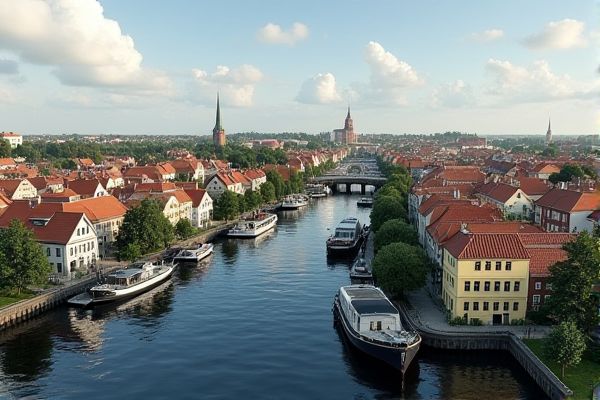
Transportation and commuting in Denmark: Extensive cycling infrastructure. Reliable public transportation system. High-quality road network. Danish railways (DSB) connectivity. Rejsekort travel card. Congestion charges in cities. Car sharing services availability. Regional bus networks. Electric vehicle incentives. Ferry connections between islands.
Extensive cycling infrastructure.
Denmark boasts an extensive cycling infrastructure, with over 385 kilometers of bike lanes in Copenhagen and a national network of 4,770 kilometers of cycle routes. The country has invested heavily in cycling infrastructure, including cycle superhighways, green cycle routes, and segregated bike paths, making cycling a safe, convenient, and popular mode of transportation. For more comprehensive details about these initiatives, you can visit the Visit Denmark website, which highlights how these developments have positioned Denmark as a global leader in bicycling culture.
Reliable public transportation system.
Denmark's public transportation system is highly reliable and efficient, featuring an extensive network of trains, buses, and metros that connect even the most remote parts of the country, with frequent services and convenient ticketing options. For more information, you can visit the Denmark Days website to explore the various public transport options available and learn about ticketing and travel tips to enhance your journey in Denmark.
High-quality road network.
Denmark boasts a high-quality road network, with a quality rating significantly above the world average. The total road network spans 73,574 km, including 1,130 km of motorways, and is largely maintained by local municipalities, with only about 5% being state roads. For more detailed insights into the country's road infrastructure, you can visit the website of The Global Economy, which provides comprehensive data on Denmark's road quality in comparison to global standards.
Danish railways (DSB) connectivity.
DSB, the Danish State Railways, operates an extensive network of regional and InterCity trains, connecting major cities like Copenhagen, Aarhus, and Odense, as well as smaller cities and countryside areas, with modern amenities such as free Wi-Fi and comfortable seating. The network includes S-trains for the capital region, regional trains, and express InterCity trains like the InterCityLyn, ensuring comprehensive and convenient transportation across Denmark. For more detailed planning and information about these services, you can visit the Visit Copenhagen website.
Rejsekort travel card.
The Rejsekort is a versatile travel card in Denmark that can be used for buses, trains, metro, and trams, available in personal, flex, and anonymous versions. It operates as both a ticket and a means of payment, with options for digital app usage and traditional chip cards, and offers various settings for single trips, commuter passes, and inter-regional travel. Visit the Rejsekort website for more detailed information about the card's functionalities and options available for travelers.
Congestion charges in cities.
In Denmark, particularly in Copenhagen, congestion charges are being considered to reduce traffic by distributing it more evenly throughout the day. Plans are underway to implement GPS technology and existing environmental zones to test this system, aiming to learn from the successes and failures of other European cities like Stockholm. For an in-depth understanding of this initiative, you can read more about it on PA Consulting.
Car sharing services availability.
In Denmark, particularly in Copenhagen, car sharing services are available through companies like GreenMobility, GoMore, and Hyre. These services offer various pricing models, including per-minute, hourly, and daily rates, with benefits such as all-inclusive costs (insurance, maintenance, and parking) and access to electric vehicles. For more insights on the impact and growth of these services, visit Sharing Mobility Services in Copenhagen to explore further. These innovative transportation solutions are part of a broader trend toward sustainable urban living.
Regional bus networks.
Denmark's regional bus networks are managed by six regional traffic companies: Nordjyllands Trafikselskab, Midttrafik, Sydtrafik, Fynbus, BAT, and Moviatrafik. These entities assign routes and networks to bus companies through public tenders. The Bus Denmark networks connect numerous cities, primarily in Jutland, providing competitive alternatives to the rail network. One of the most popular routes offered is from Aarhus to Copenhagen, serving as a crucial link within the country's public transportation system.
Electric vehicle incentives.
Denmark is paving the way for an electric vehicle revolution with a variety of incentives designed to encourage the adoption of clean transportation. Employees who are provided electric cars by their employers can benefit from a tax deduction, while there is also a tax exemption for employer-paid electricity used at workplace charging stations. New electric vehicles priced under $46,000 are eligible for substantial subsidies, complementing reduced registration taxes for low- and zero-emission cars. Furthermore, housing associations receive financial support to install charging points, significantly boosting the necessary infrastructure. To explore in detail, visit the website on Denmark's EV Revolution which offers an extensive overview of these initiatives aimed at accelerating the transition to sustainable transportation. These measures collectively underscore Denmark's commitment to an eco-friendly future.
Ferry connections between islands.
Denmark has an extensive network of ferry connections between its islands, including routes such as Ronne to Koge, Spodsbjerg to Tars, Soby to Faaborg, and Bojden to Fynshav, facilitating travel and connectivity across the various Danish islands. For more detailed information about these routes, you can visit the comprehensive guide on the Ferry Connections between Danish Islands website.
